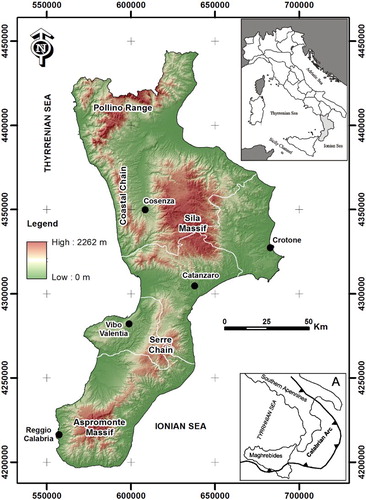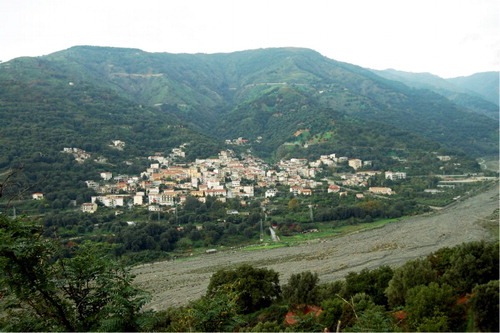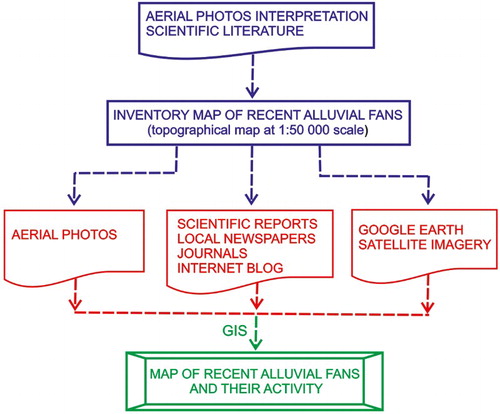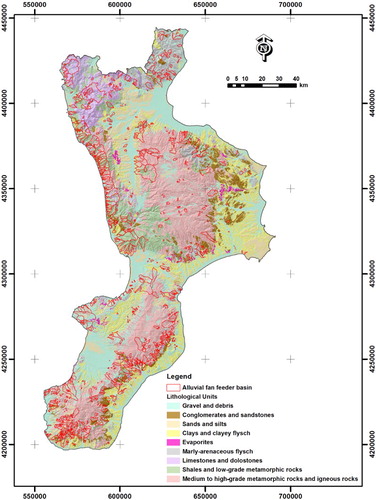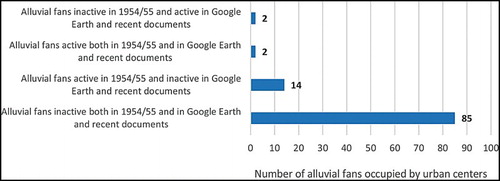Abstract
The present work aims at identifying the location of recent debris-flow-dominated alluvial fans at a regional scale in Calabria (southern Italy). Here, alluvial fans widely occur as both tributary junction and mountain front types and represent a potential hazard to human settlements and transportation links near or on them. The alluvial fans inventory map at 1:250,000 scale was obtained by means of a stereoscopic interpretation of aerial photos shot in 1954–1955. To establish the activity of the detected alluvial fans, recent documentary evidence (scientific reports, local newspapers and journals, and Internet blogs) on debris-flow events and historical satellite imagery available on Google Earth, covering the period 2001–2014, were analysed. Subsequently, the activity of the alluvial fans over the last 60 years has been divided into four classes. A total of 1170 alluvial fans have been mapped, 545 (46.58%) of which have been active over the last 60 years. The alluvial fans with a length from apex to toe < 200 m predominate, constituting 70% of the total. In the feeder basins, the dominant lithologies are represented by medium to high-grade metamorphic rocks and igneous rocks, gravel and debris and, shales and low-grade metamorphic rocks. Finally, the inventory map shows that 103 settlements are located on alluvial fans, 18 of which are active or have been active during the last 60 years. This map is a useful tool for land planning policy and for the assessment of risk deriving from debris-flows on the alluvial fans of the Calabria region.
1. Introduction
Alluvial fans, semi-conical-shaped deposition bodies, generally occur where a stream channel emerges from a mountainous catchment; they can be found everywhere in the world, in different climatic environments (CitationBlair & McPherson, 2009; CitationDavies & McSaveney, 2008; CitationDorn, 2009; CitationGuzzetti, Marchetti, & Reinchenbach, 1997; CitationHarvey, 2002; CitationHarvey et al., 1999; CitationNemec & Postma, 1993; CitationRyder, 1971; CitationSorriso-Valvo, Antronico, & Le Pera, 1998; CitationViseras, Calvache, Soria, & Fernández, 2003; CitationWhite, Drake, Millington, & Stokes, 1996). According to the type of predominant depositional process, alluvial fans are classified as debris-flow dominated or as fluvial dominated (CitationKostaschuck, MacDonald, & Putnam, 1986). Alluvial fans can also be described as tributary-junction or mountain-front fans (CitationHarvey, 1988). Research on alluvial fans has increased since the 1960s (e.g. CitationBlair & McPherson, 1994; CitationHarvey, Mater, & Stokes, 2005; CitationNilsen & Moore, 1984), owing to the need of the scientific community to address a series of multi-disciplinary issues, including environmental and geological hazard mitigation, economic geology, climate change and archaeological studies (CitationBlair & McPherson, 2009).
Calabria (southern Italy) is a region where alluvial fans widely occur. In this region, the presence of mountain fronts/alluvial and/or coastal plain, or deep and narrow valleys debouching into larger valleys are key factors for alluvial fan development. Dating of Calabria alluvial fans is not frequent; however, there is evidence that they are largely recent (Holocene) in age. The majority of recent alluvial fans are debris-flow dominated, as they relate to phases of increased landsliding activity within their feeder basin resulting in higher debris-flow hazard. Moreover, since the establishment of early human settlements (VII Century BC) and because of the dramatic increase in urbanization over the last two centuries, several of these fans have been affected by human activities, including agriculture, infrastructures and housing construction.
This map aims at displaying the location of recent, active and non-active alluvial fans in Calabria in order to examine their distribution, their activity over the last 60 years, and the main features of these landforms and related feeder basins. The identification of the fans was performed through aerial photographic interpretation, and the data collected, stored and processed using a geographic information system.
This study can be the starting point for future research perspectives on alluvial fan-related hazard, and could also be a useful tool for risk assessment deriving from debris-flows on the alluvial fans of the Calabria region.
2. Regional setting
Calabria (southern Italy) has a surface area of about 15,075 km2 with an elevation range from sea level to 2267 m, . From a geological perspective most of study area consists of crystalline-metamorphic nappe units, Palaeozoic in age, defined as the Calabrian Arc, overthrust during Early Miocene along the African-vergent Apennine–Maghrebian range ((a)). During the Late Pliocene–Early Quaternary, several high-angle faults dissected the Calabrian Arc, both longitudinally and transversally. As a result, it was fragmented into graben (where continental and marine sediments deposited) and structural highs. Since the Middle Pleistocene, a strong regional extension, together with an intense regional uplifting, affected the whole Calabrian Arc. Tectonic uplifting is still ongoing, as testified by intense seismic activity (CitationAmodio-Morelli et al., 1976; CitationCatalano, De Guidi, Monaco, Tortorici, & Tortorici, 2008; CitationTortorici, Monaco, Tansi, & Cocina, 1995; CitationWestaway, 1993).
Due to a complex geodynamic history, made of several tectonic phases, the Calabrian rocks generally show high-grade physical and chemical weathering, and different levels of fragmentation and deformation. The landscape is mountainous or hilly, with lowlands confined to local tectonic depressions and along the coasts. The mountain ridges are mostly made of crystalline-metamorphic rocks with Meso-Cenozoic sedimentary cover, except for the northernmost portion of the region, characterized by carbonate rocks. Slopes bear thick residual and colluvial covers, and are steep with peaks higher than 1500 m a.s.l. The hilly areas are mainly developed on tertiary sedimentary clastic deposits. Finally, clayey, silty, sandy and gravelly deposits crop out in the coastal plains.
Orography strongly influences the precipitation regime of the Calabrian territory (CitationCoscarelli & Caloiero, 2012), due to fronts transversally approaching the region, and convective cells climbing up the steep sea-facing side of the mountains. The mean value of average annual rainfall is about 1150 mm in Calabria. This value varies between 1000 and 2000 mm in mountainous and internal areas of the regional territory, and between 600 and 900 mm in coastal areas. The highest values (more than 2000 mm) are measured over mountainous areas; by contrast, the lowest values (less 500 mm) are observed on the coastal plains of Calabria overlooking the Ionian Sea. Over 70–80% of the annual precipitation occurs from October to March, with only 10% during the summer. Studies carried over large sample areas (CitationSorriso-Valvo, 1993) suggest that ∼25% of the regional territory is affected by landslides incidence. Heavy and/or prolonged rainfall is the primary triggering factor of mass movements.
2.1. Recent alluvial fans in Calabria
The geology of Calabria is extremely complex, resulting in environmental and landscape heterogeneity, and constitutes the dominant factor influencing the intensity and the distribution of mass movements, and thus of alluvial fans.
Studies concerning alluvial fans in several areas of Calabria characterized the sedimentary facies and differentiated the dominant sedimentary processes that control fan evolution. Results show that the large majority of fans are built by dominant debris-flow depositional processes (CitationRobustelli, Muto, Scarciglia, Spina, & Critelli, 2005; CitationSorriso-Valvo, 1988, Citation1998;CitationSorriso-Valvo & Sylvester, 1993; CitationSorriso-Valvo et al., 1998). As in many areas of the world, alluvial fans in Calabria are characterized by intermittent activity related to the intensity and frequency of the processes occurring within their catchments. Not all the alluvial fans show evidence of current activity, with active ones associated with landslide events (CitationAntronico & Sorriso-Valvo, 1996; CitationSorriso-Valvo, 1988; CitationSorriso-Valvo et al., 1998) (). Studies carried out on a set of mountain front fans along the northern part of the Tyrrhenian coast of Calabria indicate that these fans experienced a period of intense activity of construction processes during eighteenth and the end of nineteenth centuries connected with phases of increased landsliding activity within their feeder basin () (CitationAntronico & Sorriso-Valvo, 1996). More generally, the presence of a number of hydraulic engineering works within both watercourse and on the same alluvial fan (check-dams, levees, river bank protection) testifies to the intense activity of Calabrian alluvial fans in the recent past. Furthermore, currently inactive alluvial fans, characterized by erosion, have been subjected to considerable human intervention (construction of bridges, buildings, defence engineering works) (). As a result, structures and infrastructure would be at risk in case of fan reactivation. Finally, the risk that hydraulic engineering works built in the feeder channel of alluvial fans may collapse as a result of excessive sediments storage in the riverbeds should be considered. The collapse of such works (which has occurred in similar morphological and climatic areas such as Spain) may be so extensive that channelling works would be insufficient to contain debris-flow sediment; such an event may result in greater damage than the absence of riverbed defences (CitationAlcoverro, Corominas, & Gómez, 1999).
Figure 2. (a) Alluvial fan near the village of Aiello Calabro (Province of Cosenza). On 25 January 2009 shallow landslides and erosion processes, triggered by an intense rainfall event, produced relevant debris volumes that were transported along the feeder channel and deposited on the alluvial fan and the road crossing it. (b) Active alluvial fan near the village of San Lorenzo (Province of Reggio Calabria). Source: CitationSorriso-Valvo et al. (2010).

Figure 3. (a) Alluvial fan of the T. Bardano located along the narrow coastal plain on the western side of the Coastal Chain (North Calabria). Legend: (1) fan; (2) base of the mountain front; (3) erosion scarp; (4) colluvium; (5) mass movement scarp and body (a) slide, and (b) flow; (6) sea cliff; (7) artificial levee; (8) S.S. 18 bis road; (9) road; (10) railway; (11) quarry. From CitationAntronico and Sorriso-Valvo (1996). (b) Eighteenth-century building (Palazzo Bardano). Balcony turned in to a window and a window buried by debris-flows occurred during the eighteenth and the first half of the nineteenth centuries (the red arrow indicates the architrave).
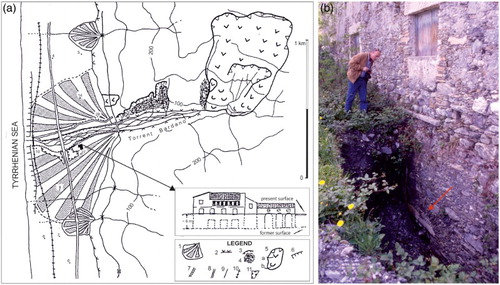
3. Materials and methods
The alluvial fans inventory map of Calabria was obtained through photo-interpretation of black and white aerial photos at ∼1:33,000 scale acquired in 1954/1955 by the Istituto Geografico Militare. Although not recent, these photos are extremely important because some landforms (including alluvial fans) are not currently recognizable due to the degree of recent urbanization and land utilization. Further information resulted from the scientific and technical literature on the topic, from the analysis of recent documents, and from field experience of the territory acquired by the authors during previous studies in Calabria (CitationAntronico, Greco, Robustelli, & Sorriso-Valvo, 2015; CitationSorriso-Valvo et al., 1998) ( and ).
Table 1. Characteristics of the aerial photographs and Google Earth satellite imagery used to prepare the alluvial fan inventory map for Calabria.
The alluvial fans inventory map at the regional scale only depicts recent debris-flow-dominated alluvial fans, not including fluvial types; large talus cones were also removed, most of which are present at the base of steep scarps made of intensely jointed calcareous-dolomitic rocks.
Following CitationBlair and McPherson (1994), a distinction has been made between Type I (predominantly debris-flow deposits) and Type II (predominantly waterfluvial deposits) fans, based on the morphological characteristics of the alluvial fans. Fan morphology is controlled by constructional processes and is tightly linked to morphology and bedrock lithology of the catchment. Type I fans have a smaller area and higher slope angles ranging between 5° and 15° on average. By contrast, Type II fans typically have average slope values between 2° and 8° (CitationBlair & McPherson, 1994; CitationCrosta & Frattini, 2004; CitationKostaschuck et al., 1986; CitationMarchi, Pasuto, & Tecca, 1993; CitationSorriso-Valvo et al., 1998).
In addition to the fan slope, in order to better discriminate between the two different types of alluvial fans, aerial photo interpretation provided verification of the morphological features of debris-flow deposits, and/or the presence of mass movements within the feeder basin.
The aerial photos acquired in 1954/1955, the analysis of recent documentary evidence (scientific reports, local newspapers and journals, Internet blogs) of debris-flow events, and historical satellite imagery available on Google Earth (covering unevenly a time span from 2001 to 2014) allowed detection of recent activity of the alluvial fans ( and ). On the basis of the aerial photos and satellite images analysis, alluvial fan surfaces showing recent depositional events such as superficial debris-flow/alluvial deposits were classified as active. In particular, along the Ionian area between Locri (Province of Reggio Calabria) and Soverato (Province of Catanzaro) the activity of the recently mapped alluvial fans was extracted from the map of mass movement, erosion and flooding caused in South Calabria by the 8–10 September 2000 storms (CitationSorriso-Valvo et al., 2004). On this map, obtained from the analysis of colour aerial photos taken immediately after the event by the Italian Civil Protection Department (), all observed phenomena have been reported, including debris-flow deposits on alluvial fans. On the basis of these criteria, four categories of alluvial fans were identified: (a) alluvial fans active both in 1954/1955 aerial photos and in Google Earth imagery and documents; (b) alluvial fans active in 1954/1955 aerial photos and inactive in Google Earth imagery and documents; (c) alluvial fans inactive in 1954/1955 aerial photos and active in Google Earth imagery and documents; and (d) alluvial fans inactive both in 1954/1955 aerial photos and in Google Earth imagery and documents.
The surveyed alluvial fans were mapped on a topographical map at 1:50,000 scale (published by the Istituto Geografico Militare Italiano), and for each alluvial fan its length was measured.
In order to produce the recent alluvial fans inventory map (Main Map) (1:250,000), the data were scanned, geo-referenced and digitized. Different colours were used to represent the four types of activity of alluvial fans.
4. Results
A total of 1170 recent alluvial fans were detected and mapped. Their spatial distribution is not uniform within the territory of Calabria. Along the narrow Tyrrhenian coastal plains, several alluvial fans are present, with the exception of small areas in the Catanzaro isthmus and in the Gioia Tauro plain. These landforms are totally absent along the Ionian Calabrian coast. Furthermore, alluvial fans are concentrated along the stream channels dissecting both the Ionian and the Tyrrhenian side of the Aspromonte-Serre system, along the right side of the Crati valley, along some stream channels dissecting the western side of the Coastal Chain to the north and to the south, at the base of the southern slope of the Mount Pollino Range (Castrovillari-Frascineto area) and, finally, along the main fiumara streams to the north of the Sibari plain (northern Ionian area).
The mapped alluvial fans were classified on the basis of the evidence noted in the methodology (i.e. Google Earth imagery, documentary evidence and historical aerial photos) ((a)). Of the 1170 mapped alluvial fans, 625 (53.42%) of them appear inactive in all sources; 462 (39.49%) are active in the historical aerial photos, but inactive in the Google Earth imagery and documentary evidence; 62 (5.3%) are active in all sources; finally, 21 (1.79%) are inactive in the historical aerial photos, but active in the Google Earth imagery and documentary evidence. In particular, alluvial fans which appear to be mostly affected by several phases of construction over the last 60 years are the ones located along stream channels dissecting the Ionian side of the Aspromonte-Serre system. With regard to the morphology of alluvial fans, more than 69% presents a length (from apex to toe) equal or less than 200 m, while the alluvial fans with a length between 200 and a length greater than 1000 m are 28.63% and 1.54%, respectively ((b)). For each alluvial fan, the drainage divide and the basin area have been calculated ().
Figure 6. Distribution of mapped alluvial fans based on (a) recent activity and (b) length from apex to toe.
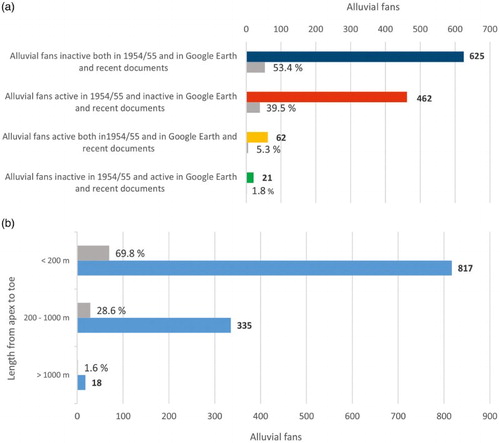
Table 2. Descriptive statistics of the basins area related to alluvial fans.
Using the 1:25,000 scale geological map of Calabria (CitationBurton, 1971), nine lithological units (LU) were defined grouping rock types that present similar compositional and mechanical characteristics. The LU determined are: gravel and debris, conglomerates and sandstones, sands and silts, clays and clayey flysch, evaporates, marly-arenaceous flysch, limestones and dolostones, shales and low-grade metamorphic rocks, medium to high-grade metamorphic rocks and igneous rocks. Alluvial fan basins predominantly overlie medium to high-grade metamorphic rocks and igneous rocks, gravel and debris, and shales and low-grade metamorphic rocks ( and ).
Generally, in densely populated areas, inactive alluvial fans are preferred sites for human settlements. Taking into account urban centres with more than 200 inhabitants, it has been calculated that 103 of them are built on alluvial fans; in particular, 85 urban centres sit on inactive alluvial fans; 14 urban centres sit on alluvial fans active in the historical aerial photos and inactive in Google Earth imagery and documentary evidence; 2 urban centres sit on active alluvial fans and, finally, 2 urban centres sit on alluvial fans inactive in the historical aerial photos and active in Google Earth imagery and documentary evidence (). Finally, the great majority of urban centres on alluvial fans are located in the administrative districts of Cosenza and Reggio Calabria.
5. Conclusions
This work aims at identifying the distribution, activity and main features of recent debris-flow-dominated alluvial fans in Calabria (southern Italy). The inventory map shows a widespread distribution of alluvial fans in the territory. A total of 1170 alluvial fans were mapped, 545 (46.58%) of which were active over the last 60 years. Alluvial fans ≤ 200 m in length predominate, as they constitute 70% of the total. In the feeder basins, the dominant lithologies are represented by medium to high-grade metamorphic rocks and igneous rocks, gravel and debris, shales and low-grade metamorphic rocks. Finally, the inventory map shows that 103 urban centres are built on alluvial fans, 18 of which are active or have been active during the last 60 years.
The recent alluvial fans inventory obtained by this study offers a good starting point for future studies on alluvial-fan hazard, and could also be a useful tool for the assessment and the mitigation of risk deriving from debris-flows on the alluvial fans of the Calabria region.
Software
The production of shaded relief visualizations, other 3D analyses and figures, map layout and final editing were performed using ESRI ArcMap 10.0.
Recent alluvial fans in Calabria (southern Italy)
Download PDF (30.2 MB)Acknowledgements
The authors thank Dr. G. Robustelli, Dr. D. Morche, and J. Abraham for providing constructive comments, which have contributed to improvement of the manuscript and map.
Disclosure statement
No potential conflict of interest was reported by the authors.
Additional information
Funding
References
- Alcoverro, J., Corominas, J., & Gómez, M. (1999). The Barranco de Arás flood of 7 August 1996 (Biescas, Central Pyrenees, Spain). Engineering Geology, 51, 237–255. doi: 10.1016/S0013-7952(98)00076-3
- Amodio-Morelli, L., Bonardi, G., Colonna, V., Dietrich, D., Giunta, G., Ippolito, F., … Zuppetta, A. (1976). L'Arco calabro-peloritano nell'orogene appennino-maghrebide. Mem. Soc. Geol. Ital., 17, 1–60.
- Antronico, L., Greco, R., Robustelli, G., & Sorriso-Valvo, M. (2015). Short-term evolution of an active basin–fan system, Aspromonte, South Italy. Geomorphology, 228, 536–551. doi:10.1016/j.geomorph.2014.10.013
- Antronico, L., & Sorriso-Valvo, M. (1996). A contribution to the assessment of the hazard deriving from debris flow on the Holocene fans of the Northern Tyrrhenian Calabria. Proc. International Conference ‘Prevention of Hydrogeological Hazard: the role of Scientific Research’, Alba, CN: CNR-GNDCI, pp. 211–220.
- Blair, T. C., & McPherson, J. G. (1994). Alluvial fans and their natural distinction from rivers based on morphology, hydraulic processes, sedimentary processes, and facies. Journal of Sedimentary Research, A64, 451–490.
- Blair, T. C., & McPherson, J. G. (2009). Alluvial fan processes and forms. In A. D. Abrahams & A. J. Parsons (Eds.), Geomorphology of desert environments (pp. 345–402). London: Chapman & Hall.
- Burton, A. N. (1971). Carta Geologica della Calabria (1:25 000), Relazione Generale. Ercolano: Poligrafia e Cartevalori.
- Catalano, S., De Guidi, G., Monaco, C., Tortorici, G., & Tortorici, L. (2008). Active faulting and seismicity along the Siculo–Calabrian Rift Zone (Southern Italy). Tectonophysics, 453, 177–192. doi: 10.1016/j.tecto.2007.05.008
- Coscarelli, R., & Caloiero, T. (2012). Analysis of daily and monthly rainfall concentration in Southern Italy (Calabria region). Journal of Hydrology, 416/417, 145–156. doi: 10.1016/j.jhydrol.2011.11.047
- Crosta, G. B., & Frattini, P. (2004). Controls on modern alluvial fan processes in the Central Alps, Northern Italy. Earth Surface Processes and Landforms, 29, 267–293. doi: 10.1002/esp.1009
- Davies, T. R. H., & McSaveney, M. J. (2008). Principles of sustainable development on fans. Journal of Hydrology (New Zealand), 47(1), 43–65.
- Dorn, R. I. (2009). The role of climatic change in alluvial fan development. In A. J. Parsons & A. D. Abrahams (Eds.), Geomorphology of desert environments (2nd ed., pp. 723–742). Dordrecht: Springer.
- Guzzetti, F., Marchetti, M., & Reichenbach, P. (1997). Large alluvial fans in the north-central Po plain (Northern Italy). Geomorphology, 18, 119–136. doi: 10.1016/S0169-555X(96)00015-3
- Harvey, A. M. (1988). Controls of alluvial fan development: The alluvial fans of the Sierra de Carrascoy, Murcia, Spain. Catena Supplement, 13, 123–137.
- Harvey, A. M. (2002). The role of base-level change in the dissection of alluvial fans: Case studies from southeast Spain and Nevada. Geomorphology, 45, 67–87. doi: 10.1016/S0169-555X(01)00190-8
- Harvey, A. M., Mater, A. E., & Stokes, M. (2005). Alluvial fans: Geomorphology, sedimentology, dynanics – introduction. A review of alluvial-fan research. In A. M. Harvey, A. E. Mater, & M. Stokes (Eds.), Alluvial Fans: Geomorphology, sedimentology, dynanics (pp. 1–7). London: Geological Society, Special Publication, 251.
- Harvey, A. M., Silva, P. G., Mather, A. E., Goy, J. L., Stokes, M., & Zazo, C. (1999). The impact of quaternary sea-level and climatic change on coastal alluvial fans in the Cabo de Gata ranges, Southeast Spain. Geomorphology, 28, 1–22. doi: 10.1016/S0169-555X(98)00100-7
- Kostaschuck, R. A., MacDonald, G. M., & Putnam, P. E. (1986). Depositional process and alluvial fan-drainage basin morphometric relationships near Banff, Alberta, Canada. Earth Surface Processes and Landforms, 11, 471–484. doi: 10.1002/esp.3290110502
- Marchi, L., Pasuto, A., & Tecca, P. R. (1993). Flow processes on alluvial fans in the Eastern Italian Alps. Zeitschrift Geomorphologie N. F., 37, 447–458.
- Nemec, W., & Postma, G. (1993). Quaternary alluvial fans in southwestern Crete: Sedimentation processes and geomorphic evolution. In M. Marzo & C. Puigdefabregas (Eds.), Alluvial sedimentation (pp. 235–276). Oxford: Blackwell Publishing.
- Nilsen, T. H., & Moore, T. E. (1984). Bibliography of alluvial-fan deposits. Norwich: Geo Books.
- Robustelli, G., Muto, F., Scarciglia, F., Spina, V., & Critelli, S. (2005). Eustatic and tectonic control on late quaternary alluvial fans along the Tyrrhenian Sea coast of Calabria (south Italy). Quaternary Science Reviews, 24, 2101–2119. doi: 10.1016/j.quascirev.2004.08.025
- Ryder, J. M. (1971). Some aspects of the morphometry of paraglacial alluvial fans in south-central British Columbia. Canadian Journal of Earth Sciences, 8, 1252–1264. doi: 10.1139/e71-114
- Sorriso-Valvo, M. (1988). Landslide-related fans in Calabria. Catena Supplement, 13, 109–121.
- Sorriso-Valvo, M. (1993). The geomorphology of Calabria. A sketch. Geografia Fisica e Dinammica Quaternaria, 16, 75–80.
- Sorriso-Valvo, M. (1998). Alluvial fans: Hazard sites and occurrences in Calabria. In K. Andah (Ed.), Managing hydro-geological disasters in a vulnerable environment (pp. 221–229). Perugia: CNR, Publication 1900.
- Sorriso-Valvo, M., Antronico, L., & Le Pera, E. (1998). Controls on modern fan morphology in Calabria, Southern Italy. Geomorphology, 24, 169–187. doi: 10.1016/S0169-555X(97)00079-2
- Sorriso-Valvo, M., Antronico, L., Gaudio, R., Gullà, G., Iovine, G., Merenda, G., … Terranova, O. (2004). Carta dei dissesti causati in Calabria meridionale dall'evento meteorologico dell'8–10 settembre 2000. Soveria Mannelli: Rubbettino Industrie Grafiche ed Editoriali.
- Sorriso-Valvo, M., Antronico, L., Gullà, G., Iovine, G., Marchi, L., Petrucci, O., … Pasqua, A. A. (2010). Pericolosità delle conoidi alluvionali – Relazione Finale. Lotto 4, POR Calabria 2000–2006, Azione 1.4c, p. 244. Unpublished manuscript.
- Sorriso-Valvo, M., & Sylvester, A. (1993). The relationship between geology and landforms along a coastal mountain front, Northern Calabria, Italy. Earth Surface Processes and Landforms, 18, 257–273. doi: 10.1002/esp.3290180307
- Tortorici, L., Monaco, C., Tansi, C., & Cocina, O. (1995). Recent and active tectonics in the Calabrian arc (Southern Italy). Tectonophysics, 243, 37–55. doi: 10.1016/0040-1951(94)00190-K
- Viseras, C., Calvache, M. L., Soria, J. M., & Fernández, J. (2003). Differential features of alluvial fans controlled by tectonic or eustatic accommodation space. Examples from the Betic Cordillera, Spain. Geomorphology, 50, 181–202. doi: 10.1016/S0169-555X(02)00214-3
- Westaway, R. (1993). Quaternary uplift of Southern Italy. Journal of Geophysical Research, 98, 741–772.
- White, K., Drake, N., Millington, A., & Stokes, S. (1996). Constraining the timing of alluvial fan response to late quaternary climatic changes, Southern Tunisia. Geomorphology, 17, 295–304. doi: 10.1016/0169-555X(96)00011-6

